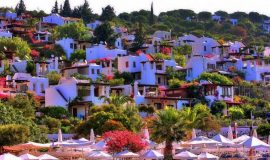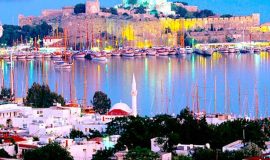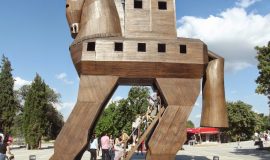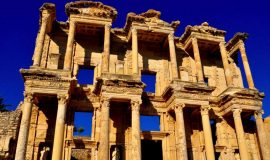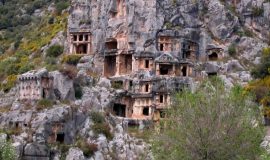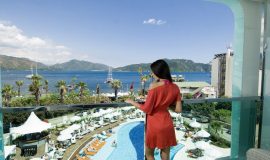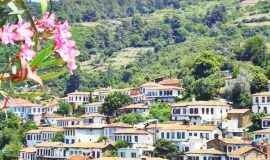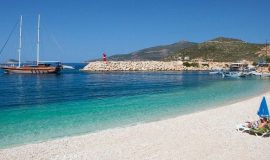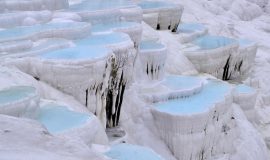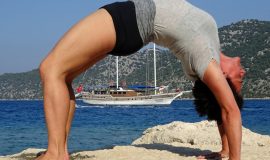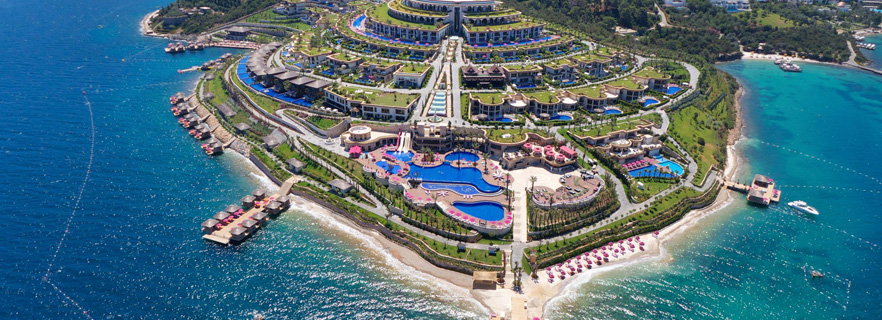
In the Aegean Region, Bodrum is a district of Muğla, surrounded by Milas in the east and north east, and the Aegean in the north and west and south in the south. The district is located on a peninsula between Güllük in the north and Gokova Gulf in the south. The districts are rugged and the inner parts are plain, the coasts are very indented and protruding, it is composed of areas with a lot of limestone content due to its soil structure. The county lands the Land of Yarand and the mountains of Pazar. The Yaran Mountain (879 m.) Extending in the northeast-southwest direction is located in the eastern and central part of the county. This mountain descends to the west to 690 m. It forms the Mountain of Mount Sinai at height.
There are depression areas and associated valleys, which open directly to the sea in the coastal area of the province and which form small basins in the inner part. In the valley and depression areas there are plains where alluviums carried by the rivers bring to the waterfall. Bitez Plain, Akçalan Plain and Karaova are the main ones. The district bordering is fairly smooth in the south and has an indented, protruding appearance in the southwest, west and north. Within the borders of the town are Çakal Island, Karaada and many other small islands. There is no river in the district. Irrigation Pond located in Mumcular Beld is used as irrigation and drinking water. The coast length of the province is 174 km. 115 km to the city center. The distance of the province is 557 km2 and the total population is 56.400.
The divider is divided into two very distinctly as vegetation. It is covered with bushes and bushes and thorny grasses on the part of the Bodrum-Milas highway. The area east of the road is covered with coniferous pinaceae, oak, bonito, wild strawberry, myrtle and sandalwood trees. 61.3% of the province is covered with forests
It is a synthesis of the Aegean and Mediterranean climates in terms of climate. As a peninsula, it shows micro-conditioning feature. The winter months are very low. The summer months are hot and dry, the winter months are very warm and rainy.
The county economy is based on tourism, commerce, crafts, fishing, forestry, and herbal production. The amount of crop production is low due to the inadequacy of cultivated areas. Tobacco, olive production, however, is important. Greenhousing is done beside the vegetable. Fruit growing, especially tangerine production. In recent years, breeding work has become an important source of livelihood income for the public. Traditional sponge fishing and fishing have begun to lose their former significance. Carpet and rug weaving are done in villages connected to Karaova.
Tourism has become the main economic activity of Bodrum in recent years. Tourism is based on small handicraft trade and attracts tourists with its historical texture.
The ancient name of Halicarnassus is based on the very fact that Bodrum is at the junction of the Mediterranean and the Aegean Sea. Mugla and a part of the region that contains Aydın is called Karia in Antiquity. The local people are Karlar and Lelegler. They lived in the villages that they had built on the high hills from the shore, and rounded them around.
The ancient Halikarnassos was built in the middle of the two harbors and in the vicinity of Göktepe, behind the area where today's fortress is located. As a matter of fact, the research and basic excavations made here reveal a lot of finds related to the ancient city. Vitrivirus made a topographic presentation of Halikarnasso and compared the city to the theater cave. Meanwhile, he spoke of Aphrodite and Hermes on the hill to the right of the city. Today this place is the site of the Cafer Pasha Tomb and the Turkish graveyard in the western part of the harbor. To the east of the city is the palace of Maussollos. It is believed that the inner harbor is located near the present Tepecik Mosque. The location of the secret port reached by a secret corridor from the palace of Maussollos is controversial today. On the hill behind Tepecik Camis was the monumental statue of Mars, the sanctuary of the god of war Mars (Ares), the temple and Timetos. No trace of the remains and finds came from these days.
The artifacts found in the Bodrum Underwater Archeology Museum show that the settlement on the site had descended to 5000 BC. In fact, the finds here indicate that the region has been undergoing various invasions originating from the Aegean islands for centuries and that different civilizations have followed each other. Besides, the tombs discovered in Çömlekçi, Yalikavak and Müskebi, which are very close to Bodrum in recent years, and their finds point to the fact that Myken lived here.
Heredotos, a historian of Halikarnassos (BC484-425), attributed the establishment of the city to the colonists, saying, "The caryans came from the islands to the mainland." Heredotos said that the first arrivals of Bodrum were founded by Dorlar from Trozien, east of the Mora Peninsula They added that they had settled in Zephyros Island, which is the western wind, where the castle was, and they were holding it along the shore.The real people living in the area are the Karyans and Lelegler.
Homer also voiced the defiance of the native Carian, along with the Trojans, who came from Greece, in the epic of the Iliad.
Halikarnassos is the sixth member of the Doric Union founded by Dor Colonists, after Knidos, Kos, Lindos, Kmiros and Iasos. However, because God did not present the triple-legged bronze boiler they had acquired in the games held in the center of the union, Apollo, in Knidos, God was regarded as a disrespect for Apollo and removed from the unity. Halicarnassus was closer to the Ionians and took the appearance of an Ionian city from the political and economic side of the century BC.
Halikarnassos had to recognize the sovereignty of the Lydians as well as Karya at the beginning of the century BC. In the following century, the Kariyilar, Lydians and Mysians counted each other as sister tribes. Upon the capture of the Persians by Lydia, Halicarnassus, like other western Anatolian cities, accepted their sovereignty.
Persians brought their ruling sages under the name "Tirana" in the cities they had under their sovereignty in Anatolia, and in the end of the century BC, beside the Persian king Kserkes, there was also the queen I.Artemisia, the daughter of Halikarnassos tyrant Ligdamis. The Kosians, the Nisyros and the Kalydonos also participated, while I. Artemisia had advised the Persian king to make a naval war against Greece, and his request was fulfilled, and the queen himself joined it.
After Halicarnassos I.Artemisia, his son Psindalis, then his son Ligdamis became a tyrant. These tyrants are faint-hearted people who have not been mentioned in history. In the tyranny of II.Ligdamus, the Halicarnassians had hard times and were oppressed under oppressive rule. Heredetus, meanwhile, abandoned the place where he had been born with his cruelty and returned after a while. Halicarnassus, Ionia ihtililin joined the member of the Attica-Delos Maritime Association in 468 BC. We learn that Halikarnassos paid less than Union members of Historical sources, Termera and Pedesa. After the Persians re-dominated the region in the beginning of the Millennium BC some parts of Anatolia were separated from the Spartans and the region of Karya was divided into Hacatomnos syllaines Management. After the death of Hekatomnos, Maussolos replaced the center of the Karya Satrapli in Halikarnassos in 366 BC.
The ease of defense of Halikarnassos has been influenced by trade and maritime positioning and has led to its rapid development. In this way, Maussollos was forced to live in Halikarnassos, living in the eight Lelegian towns around him, seized Rhodes and Kos, and tying it to Lycia as a sovereign. In order to make the developing and enriching city more beautiful, the famous architects and sculptors of the age are collected in Halikarnassos. Maussollos is 7km away with the aim of protecting the city. The Sur Walls in its length surround the city spreading in the form of an amphitheater around the harbor. The royal palace, which was built in the area called Zephyria, which is an island, and later connected to the mainland, was placed so as to control the entire city. B.C. After the death of Maussollos in 353, Halicarnassus was ruled by his own sister and also his wife Artemisia II. Artemisia's husband, Mausollos, 49m. The tomb in the height was magnificently raised in the middle of the city of Mausuleum and counted as one of the seven wonders of the antique age. After the death of Artemisia II, İderus married his sister Ada and his wife Ada satrap after his death, but then he was expelled from Halicarnassos by his younger brother Piksadoros. Halicarnassos who entered the administration of the Persian Satrap Othontopates later, In 334, Alexander became a part of Karia.
When Alexander the Great seized the city in 334, he recalled Ada to govern the city. After that the city remained independent until December 9, In 133 BC, it continued to exist as a small city connected to the Asian state of Rome. Then Halicarnassos, a part of the Byzantine and Seljuk states, He's been under the rule of John Knights. St. Zephyria The castle, which was built in the name of Peter, was used as a dungeon during the reign of the Ottoman State in 1522. Halicarnassus joined the Ottoman lands in 1523 during Kanuni Sultan Süleyman's expedition to Rhodes.
Bodrum was bombarded by the Russian fleet in 1770 and the French Duplex army on 26 May 1915. After World War I, Bodrum was occupied by Italians on May 11, 1919. During the War of Independence, the Italians withdrew from the province on July 5, 1921 and ended the occupation. After the declaration of the Republic, it was brought to the district of Muğla.
Among the historical monuments in the district are Bodrum Bodrum Castle, Boz Kale, Mustafa Pasha Mosque, Tepecik Mosque, Adliye Mosque, Bodrum Underwater Archeology Museum, Kale Hamami, Hacı Molla Hanı, Bodrum Castle Chapel, Bodrum Kümbetleri, Bodrum Yel Mills, There are homes for families. Also in the district; There are natural beauties such as Tavşanburnu Spa, Karaada Spa, Fok Cave, Bay and Bükler.
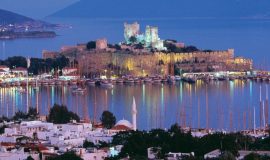

 In the Aegean Region, Bodrum is a district of Muğla, surrounded by Milas in the east and north east, and the Aegean in the north and west and south in the south. The district is located on a peninsula between Güllük in the north and Gokova Gulf in the south. The districts are rugged and the inner parts are plain, the coasts are very indented and protruding, it is composed of areas with a lot of limestone content due to its soil structure. The county lands the Land of Yarand and the mountains of Pazar. The Yaran Mountain (879 m.) Extending in the northeast-southwest direction is located in the eastern and central part of the county. This mountain descends to the west to 690 m. It forms the Mountain of Mount Sinai at height.
There are depression areas and associated valleys, which open directly to the sea in the coastal area of the province and which form small basins in the inner part. In the valley and depression areas there are plains where alluviums carried by the rivers bring to the waterfall. Bitez Plain, Akçalan Plain and Karaova are the main ones. The district bordering is fairly smooth in the south and has an indented, protruding appearance in the southwest, west and north. Within the borders of the town are Çakal Island, Karaada and many other small islands. There is no river in the district. Irrigation Pond located in Mumcular Beld is used as irrigation and drinking water. The coast length of the province is 174 km. 115 km to the city center. The distance of the province is 557 km2 and the total population is 56.400.
The divider is divided into two very distinctly as vegetation. It is covered with bushes and bushes and thorny grasses on the part of the Bodrum-Milas highway. The area east of the road is covered with coniferous pinaceae, oak, bonito, wild strawberry, myrtle and sandalwood trees. 61.3% of the province is covered with forests
It is a synthesis of the Aegean and Mediterranean climates in terms of climate. As a peninsula, it shows micro-conditioning feature. The winter months are very low. The summer months are hot and dry, the winter months are very warm and rainy.
The county economy is based on tourism, commerce, crafts, fishing, forestry, and herbal production. The amount of crop production is low due to the inadequacy of cultivated areas. Tobacco, olive production, however, is important. Greenhousing is done beside the vegetable. Fruit growing, especially tangerine production. In recent years, breeding work has become an important source of livelihood income for the public. Traditional sponge fishing and fishing have begun to lose their former significance. Carpet and rug weaving are done in villages connected to Karaova.
Tourism has become the main economic activity of Bodrum in recent years. Tourism is based on small handicraft trade and attracts tourists with its historical texture.
The ancient name of Halicarnassus is based on the very fact that Bodrum is at the junction of the Mediterranean and the Aegean Sea. Mugla and a part of the region that contains Aydın is called Karia in Antiquity. The local people are Karlar and Lelegler. They lived in the villages that they had built on the high hills from the shore, and rounded them around.
The ancient Halikarnassos was built in the middle of the two harbors and in the vicinity of Göktepe, behind the area where today's fortress is located. As a matter of fact, the research and basic excavations made here reveal a lot of finds related to the ancient city. Vitrivirus made a topographic presentation of Halikarnasso and compared the city to the theater cave. Meanwhile, he spoke of Aphrodite and Hermes on the hill to the right of the city. Today this place is the site of the Cafer Pasha Tomb and the Turkish graveyard in the western part of the harbor. To the east of the city is the palace of Maussollos. It is believed that the inner harbor is located near the present Tepecik Mosque. The location of the secret port reached by a secret corridor from the palace of Maussollos is controversial today. On the hill behind Tepecik Camis was the monumental statue of Mars, the sanctuary of the god of war Mars (Ares), the temple and Timetos. No trace of the remains and finds came from these days.
The artifacts found in the Bodrum Underwater Archeology Museum show that the settlement on the site had descended to 5000 BC. In fact, the finds here indicate that the region has been undergoing various invasions originating from the Aegean islands for centuries and that different civilizations have followed each other. Besides, the tombs discovered in Çömlekçi, Yalikavak and Müskebi, which are very close to Bodrum in recent years, and their finds point to the fact that Myken lived here.
Heredotos, a historian of Halikarnassos (BC484-425), attributed the establishment of the city to the colonists, saying, "The caryans came from the islands to the mainland." Heredotos said that the first arrivals of Bodrum were founded by Dorlar from Trozien, east of the Mora Peninsula They added that they had settled in Zephyros Island, which is the western wind, where the castle was, and they were holding it along the shore.The real people living in the area are the Karyans and Lelegler.
Homer also voiced the defiance of the native Carian, along with the Trojans, who came from Greece, in the epic of the Iliad.
Halikarnassos is the sixth member of the Doric Union founded by Dor Colonists, after Knidos, Kos, Lindos, Kmiros and Iasos. However, because God did not present the triple-legged bronze boiler they had acquired in the games held in the center of the union, Apollo, in Knidos, God was regarded as a disrespect for Apollo and removed from the unity. Halicarnassus was closer to the Ionians and took the appearance of an Ionian city from the political and economic side of the century BC.
Halikarnassos had to recognize the sovereignty of the Lydians as well as Karya at the beginning of the century BC. In the following century, the Kariyilar, Lydians and Mysians counted each other as sister tribes. Upon the capture of the Persians by Lydia, Halicarnassus, like other western Anatolian cities, accepted their sovereignty.
Persians brought their ruling sages under the name "Tirana" in the cities they had under their sovereignty in Anatolia, and in the end of the century BC, beside the Persian king Kserkes, there was also the queen I.Artemisia, the daughter of Halikarnassos tyrant Ligdamis. The Kosians, the Nisyros and the Kalydonos also participated, while I. Artemisia had advised the Persian king to make a naval war against Greece, and his request was fulfilled, and the queen himself joined it.
After Halicarnassos I.Artemisia, his son Psindalis, then his son Ligdamis became a tyrant. These tyrants are faint-hearted people who have not been mentioned in history. In the tyranny of II.Ligdamus, the Halicarnassians had hard times and were oppressed under oppressive rule. Heredetus, meanwhile, abandoned the place where he had been born with his cruelty and returned after a while. Halicarnassus, Ionia ihtililin joined the member of the Attica-Delos Maritime Association in 468 BC. We learn that Halikarnassos paid less than Union members of Historical sources, Termera and Pedesa. After the Persians re-dominated the region in the beginning of the Millennium BC some parts of Anatolia were separated from the Spartans and the region of Karya was divided into Hacatomnos syllaines Management. After the death of Hekatomnos, Maussolos replaced the center of the Karya Satrapli in Halikarnassos in 366 BC.
The ease of defense of Halikarnassos has been influenced by trade and maritime positioning and has led to its rapid development. In this way, Maussollos was forced to live in Halikarnassos, living in the eight Lelegian towns around him, seized Rhodes and Kos, and tying it to Lycia as a sovereign. In order to make the developing and enriching city more beautiful, the famous architects and sculptors of the age are collected in Halikarnassos. Maussollos is 7km away with the aim of protecting the city. The Sur Walls in its length surround the city spreading in the form of an amphitheater around the harbor. The royal palace, which was built in the area called Zephyria, which is an island, and later connected to the mainland, was placed so as to control the entire city. B.C. After the death of Maussollos in 353, Halicarnassus was ruled by his own sister and also his wife Artemisia II. Artemisia's husband, Mausollos, 49m. The tomb in the height was magnificently raised in the middle of the city of Mausuleum and counted as one of the seven wonders of the antique age. After the death of Artemisia II, İderus married his sister Ada and his wife Ada satrap after his death, but then he was expelled from Halicarnassos by his younger brother Piksadoros. Halicarnassos who entered the administration of the Persian Satrap Othontopates later, In 334, Alexander became a part of Karia.
When Alexander the Great seized the city in 334, he recalled Ada to govern the city. After that the city remained independent until December 9, In 133 BC, it continued to exist as a small city connected to the Asian state of Rome. Then Halicarnassos, a part of the Byzantine and Seljuk states, He's been under the rule of John Knights. St. Zephyria The castle, which was built in the name of Peter, was used as a dungeon during the reign of the Ottoman State in 1522. Halicarnassus joined the Ottoman lands in 1523 during Kanuni Sultan Süleyman's expedition to Rhodes.
Bodrum was bombarded by the Russian fleet in 1770 and the French Duplex army on 26 May 1915. After World War I, Bodrum was occupied by Italians on May 11, 1919. During the War of Independence, the Italians withdrew from the province on July 5, 1921 and ended the occupation. After the declaration of the Republic, it was brought to the district of Muğla.
Among the historical monuments in the district are Bodrum Bodrum Castle, Boz Kale, Mustafa Pasha Mosque, Tepecik Mosque, Adliye Mosque, Bodrum Underwater Archeology Museum, Kale Hamami, Hacı Molla Hanı, Bodrum Castle Chapel, Bodrum Kümbetleri, Bodrum Yel Mills, There are homes for families. Also in the district; There are natural beauties such as Tavşanburnu Spa, Karaada Spa, Fok Cave, Bay and Bükler.
In the Aegean Region, Bodrum is a district of Muğla, surrounded by Milas in the east and north east, and the Aegean in the north and west and south in the south. The district is located on a peninsula between Güllük in the north and Gokova Gulf in the south. The districts are rugged and the inner parts are plain, the coasts are very indented and protruding, it is composed of areas with a lot of limestone content due to its soil structure. The county lands the Land of Yarand and the mountains of Pazar. The Yaran Mountain (879 m.) Extending in the northeast-southwest direction is located in the eastern and central part of the county. This mountain descends to the west to 690 m. It forms the Mountain of Mount Sinai at height.
There are depression areas and associated valleys, which open directly to the sea in the coastal area of the province and which form small basins in the inner part. In the valley and depression areas there are plains where alluviums carried by the rivers bring to the waterfall. Bitez Plain, Akçalan Plain and Karaova are the main ones. The district bordering is fairly smooth in the south and has an indented, protruding appearance in the southwest, west and north. Within the borders of the town are Çakal Island, Karaada and many other small islands. There is no river in the district. Irrigation Pond located in Mumcular Beld is used as irrigation and drinking water. The coast length of the province is 174 km. 115 km to the city center. The distance of the province is 557 km2 and the total population is 56.400.
The divider is divided into two very distinctly as vegetation. It is covered with bushes and bushes and thorny grasses on the part of the Bodrum-Milas highway. The area east of the road is covered with coniferous pinaceae, oak, bonito, wild strawberry, myrtle and sandalwood trees. 61.3% of the province is covered with forests
It is a synthesis of the Aegean and Mediterranean climates in terms of climate. As a peninsula, it shows micro-conditioning feature. The winter months are very low. The summer months are hot and dry, the winter months are very warm and rainy.
The county economy is based on tourism, commerce, crafts, fishing, forestry, and herbal production. The amount of crop production is low due to the inadequacy of cultivated areas. Tobacco, olive production, however, is important. Greenhousing is done beside the vegetable. Fruit growing, especially tangerine production. In recent years, breeding work has become an important source of livelihood income for the public. Traditional sponge fishing and fishing have begun to lose their former significance. Carpet and rug weaving are done in villages connected to Karaova.
Tourism has become the main economic activity of Bodrum in recent years. Tourism is based on small handicraft trade and attracts tourists with its historical texture.
The ancient name of Halicarnassus is based on the very fact that Bodrum is at the junction of the Mediterranean and the Aegean Sea. Mugla and a part of the region that contains Aydın is called Karia in Antiquity. The local people are Karlar and Lelegler. They lived in the villages that they had built on the high hills from the shore, and rounded them around.
The ancient Halikarnassos was built in the middle of the two harbors and in the vicinity of Göktepe, behind the area where today's fortress is located. As a matter of fact, the research and basic excavations made here reveal a lot of finds related to the ancient city. Vitrivirus made a topographic presentation of Halikarnasso and compared the city to the theater cave. Meanwhile, he spoke of Aphrodite and Hermes on the hill to the right of the city. Today this place is the site of the Cafer Pasha Tomb and the Turkish graveyard in the western part of the harbor. To the east of the city is the palace of Maussollos. It is believed that the inner harbor is located near the present Tepecik Mosque. The location of the secret port reached by a secret corridor from the palace of Maussollos is controversial today. On the hill behind Tepecik Camis was the monumental statue of Mars, the sanctuary of the god of war Mars (Ares), the temple and Timetos. No trace of the remains and finds came from these days.
The artifacts found in the Bodrum Underwater Archeology Museum show that the settlement on the site had descended to 5000 BC. In fact, the finds here indicate that the region has been undergoing various invasions originating from the Aegean islands for centuries and that different civilizations have followed each other. Besides, the tombs discovered in Çömlekçi, Yalikavak and Müskebi, which are very close to Bodrum in recent years, and their finds point to the fact that Myken lived here.
Heredotos, a historian of Halikarnassos (BC484-425), attributed the establishment of the city to the colonists, saying, "The caryans came from the islands to the mainland." Heredotos said that the first arrivals of Bodrum were founded by Dorlar from Trozien, east of the Mora Peninsula They added that they had settled in Zephyros Island, which is the western wind, where the castle was, and they were holding it along the shore.The real people living in the area are the Karyans and Lelegler.
Homer also voiced the defiance of the native Carian, along with the Trojans, who came from Greece, in the epic of the Iliad.
Halikarnassos is the sixth member of the Doric Union founded by Dor Colonists, after Knidos, Kos, Lindos, Kmiros and Iasos. However, because God did not present the triple-legged bronze boiler they had acquired in the games held in the center of the union, Apollo, in Knidos, God was regarded as a disrespect for Apollo and removed from the unity. Halicarnassus was closer to the Ionians and took the appearance of an Ionian city from the political and economic side of the century BC.
Halikarnassos had to recognize the sovereignty of the Lydians as well as Karya at the beginning of the century BC. In the following century, the Kariyilar, Lydians and Mysians counted each other as sister tribes. Upon the capture of the Persians by Lydia, Halicarnassus, like other western Anatolian cities, accepted their sovereignty.
Persians brought their ruling sages under the name "Tirana" in the cities they had under their sovereignty in Anatolia, and in the end of the century BC, beside the Persian king Kserkes, there was also the queen I.Artemisia, the daughter of Halikarnassos tyrant Ligdamis. The Kosians, the Nisyros and the Kalydonos also participated, while I. Artemisia had advised the Persian king to make a naval war against Greece, and his request was fulfilled, and the queen himself joined it.
After Halicarnassos I.Artemisia, his son Psindalis, then his son Ligdamis became a tyrant. These tyrants are faint-hearted people who have not been mentioned in history. In the tyranny of II.Ligdamus, the Halicarnassians had hard times and were oppressed under oppressive rule. Heredetus, meanwhile, abandoned the place where he had been born with his cruelty and returned after a while. Halicarnassus, Ionia ihtililin joined the member of the Attica-Delos Maritime Association in 468 BC. We learn that Halikarnassos paid less than Union members of Historical sources, Termera and Pedesa. After the Persians re-dominated the region in the beginning of the Millennium BC some parts of Anatolia were separated from the Spartans and the region of Karya was divided into Hacatomnos syllaines Management. After the death of Hekatomnos, Maussolos replaced the center of the Karya Satrapli in Halikarnassos in 366 BC.
The ease of defense of Halikarnassos has been influenced by trade and maritime positioning and has led to its rapid development. In this way, Maussollos was forced to live in Halikarnassos, living in the eight Lelegian towns around him, seized Rhodes and Kos, and tying it to Lycia as a sovereign. In order to make the developing and enriching city more beautiful, the famous architects and sculptors of the age are collected in Halikarnassos. Maussollos is 7km away with the aim of protecting the city. The Sur Walls in its length surround the city spreading in the form of an amphitheater around the harbor. The royal palace, which was built in the area called Zephyria, which is an island, and later connected to the mainland, was placed so as to control the entire city. B.C. After the death of Maussollos in 353, Halicarnassus was ruled by his own sister and also his wife Artemisia II. Artemisia's husband, Mausollos, 49m. The tomb in the height was magnificently raised in the middle of the city of Mausuleum and counted as one of the seven wonders of the antique age. After the death of Artemisia II, İderus married his sister Ada and his wife Ada satrap after his death, but then he was expelled from Halicarnassos by his younger brother Piksadoros. Halicarnassos who entered the administration of the Persian Satrap Othontopates later, In 334, Alexander became a part of Karia.
When Alexander the Great seized the city in 334, he recalled Ada to govern the city. After that the city remained independent until December 9, In 133 BC, it continued to exist as a small city connected to the Asian state of Rome. Then Halicarnassos, a part of the Byzantine and Seljuk states, He's been under the rule of John Knights. St. Zephyria The castle, which was built in the name of Peter, was used as a dungeon during the reign of the Ottoman State in 1522. Halicarnassus joined the Ottoman lands in 1523 during Kanuni Sultan Süleyman's expedition to Rhodes.
Bodrum was bombarded by the Russian fleet in 1770 and the French Duplex army on 26 May 1915. After World War I, Bodrum was occupied by Italians on May 11, 1919. During the War of Independence, the Italians withdrew from the province on July 5, 1921 and ended the occupation. After the declaration of the Republic, it was brought to the district of Muğla.
Among the historical monuments in the district are Bodrum Bodrum Castle, Boz Kale, Mustafa Pasha Mosque, Tepecik Mosque, Adliye Mosque, Bodrum Underwater Archeology Museum, Kale Hamami, Hacı Molla Hanı, Bodrum Castle Chapel, Bodrum Kümbetleri, Bodrum Yel Mills, There are homes for families. Also in the district; There are natural beauties such as Tavşanburnu Spa, Karaada Spa, Fok Cave, Bay and Bükler. 